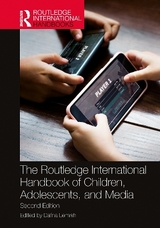
The Routledge International Handbook of Children, Adolescents and Media
Routledge (Verlag)
978-1-138-84913-6 (ISBN)
- Titel erscheint in neuer Auflage
- Artikel merken
The roles that media play in the lives of children and adolescents, as well as their potential implications for their cognitive, emotional, social and behavioral development, have attracted growing research attention in a variety of disciplines.
The Routledge International Handbook of Children, Adolescents and Media analyses a broad range of complementary areas of study, including children as media consumers, children as active participants in media making, and representations of children in the media. The handbook presents a collection that spans a variety of disciplines including developmental psychology, media studies, public health, education, feminist studies and the sociology of childhood. Essays provide a unique intellectual mapping of current knowledge, exploring the relationship of children and media in local, national, and global contexts.
Divided into five parts, each with an introduction explaining the themes and topics covered, the handbook features 57 new contributions from 71 leading academics from 38 countries. Chapters consider vital questions by analyzing texts, audience, and institutions, including:
the role of policy and parenting in regulating media for children
the relationships between children’s’ on-line and off-line social networks
children’s strategies of resistance to persuasive messages in advertising
media and the construction of gender and ethnic identities
The Handbook’s interdisciplinary approach and comprehensive, international scope make it an authoritative, state of the art guide to the nascent field of Children’s Media Studies. It will be indispensable for media scholars and professionals, policy makers, educators, and parents.
Dafna Lemish is Professor of Communication, Interim Dean of the College of Mass Communication and Media Arts at Southern Illinois University Carbondale and founding editor of the Journal of Children and Media (http://tandfonline.com/rchm). She is author of numerous books and articles on children, media and gender representations.
Foreword Maire Messenger Davies. Creating a shared scholarly arena: Editor’s Introduction Dafna Lemish. Part 1: Childhoods and Constructions Editor’s Introduction. 1. The co-construction of media and childhood Kirsten Drotner 2.Representations of childhood in the media Debbie Olson and Giselle Rampaul 3. Trends in children’s consumption of media Uwe Hasebrink and Ingrid Paus-Hasebrink 4. Examining the assumptions in research on children and media Mariana Krcmar 5. Ecological approaches to the study of media and children Elizabeth Vandewater 6. Constructing children as consumers David Buckingham 7.Critical studies: Practice not discipline Karen Orr Vered 8. Feminist theories approaches to the study of children and media Dafna Lemish 9. Media culture and childhood in the age of globalization Radhika Parameswaran Part 2: Channels and Convergence Editor’s Introduction. 1. Children’s print culture: Tradition and innovation Carol L. Tilley 2. Children’s film culture Stephanie Hemelryk Donald and Kirsten Seale 3. Children’s television culture Jeannette Steemers 4. Children’s Internet culture: Power, change and vulnerability in twenty-first century childhood Sonia Livingstone 5. Children’s digital gaming cultures Pål Aarsand 6. Mobile communication culture among children and adolescents Rich Ling and Troels Bertel 7. Children’s music culture: Commerce, technology, and tradition Tyler Bickford 8. Children and consumer culture Kara Chan 9. Children and convergence culture: New perspectives on youth participation with media Meryl Alper 10. Children’s technologized bodies: Mapping mixed reality Meenakshi Gigi Durham Part 3: Concerns and Consequences Editor’s Introduction. 1. Screen media, early cognitive development and language: Babies learning from screens Deborah L. Linebarger 2. Children’s media use and its relation to attention, hyperactivity and impulsivity Mariette Huizinga, Sanne W.C. Nikkelen, and Patti M. Valkenburg 3. Media, imagination and fantasy Maya Götz 4. Social media and creativity Kylie Peppler 5. Media and emotional development Nicole Martins 6. The behavioral, affective, and cognitive implications of media violence: Complex relationships between young people and texts Erica Scharrer 7. Media and sexual development Peter Jochen 8. Media, body image and eating disorders Kirsten Harrison 9. Media and obesity Bradley J. Bond, Melissa N. Richards, and Sandra L. Calvert 10. Media and substance abuse: Alcohol, smoking and drugs Dina L.G. Borzekowski 11. Media and learning of the social world Jeanne Prinsloo 12. Children and the news: Rethinking citizenship in the 21st century Cynthia Carter 13. Processes and Impacts of Political Socialization Erica Weintraub Austin 14. Media advertising and consumerism: How children and adolescents understand and resist persuasive messages Moniek Buijzen, Esther Rozendaal, and Eva A. van Reijmersdal 15. Media and gender identities: Learning and performing femininity and masculinity Sharon R. Mazzarella 16. Internet media and peer sociability Gustavo Mesch Part 4: Contexts and Communities Editor’s Introduction. 1. Media and the family context Amy I. Nathanson 2. Media and spaces: The mobile phone in the geographies of young people Rivka Ribak 3. Media and bedroom culture Sian Lincoln 4. Media and peer culture: Youths sharing norms and collective identities with and through media Sun Sun Lim 5. Media and minority children Michelle M. Rivera and Angharad N. Valdivia 6. Immigrant children and media Nelly Elias 7. Young people producing media: Spontaneous and project-sponsored media creation around the world JoEllen Fisherkeller 8. Media and civic engagement: The role of Web 2.0 technologies in fostering youth participation Tao Papaioannou 9. Media, participation and social change: Working within a "Youth as Knowledge Producers" framework Jean Stuart and Claudia Mitchell Part 5: Collaborations and Companions Editor’s Introduction. 1. Media policies for children: Issues and histories in the U.S. Norma Pecora 2. Media regulation: The protection and promotion of home-grown children’s television Katalin Lustyik 3. Children and advertising policies in the U.S. and beyond Amy Beth Jordan and Joelle Sano Gilmore 4. Internet policies: Online child protection and empowerment in a global context Brian O’Neill 5. Learning from educational television Shalom M. Fisch 6. New media and learning Becky Herr Stephenson 7. Media literacy Renee Hobbs 8. Challenges and suggestions for determining quality in children’s media Alexis R. Lauricella, Michael B. Robb and Ellen Wartella 9. UNICEF and communication for development: An integrated approach to developing capacity to produce communication for and with children Barbara Kolucki 10. International initiatives concerning children and media: Networks, associations, organizations, institutions and forums Cecilia von Feilitzen 11. The medical community in the U.S.: Treating media as an influence on health and development Michael Rich 12. Bridging scholarship and the media industry: How public broadcasting works with academia Linda Simensky
| Erscheint lt. Verlag | 8.1.2015 |
|---|---|
| Zusatzinfo | 6 Tables, black and white |
| Verlagsort | London |
| Sprache | englisch |
| Maße | 174 x 246 mm |
| Gewicht | 861 g |
| Themenwelt | Geisteswissenschaften ► Geschichte |
| Geisteswissenschaften ► Psychologie ► Allgemeine Psychologie | |
| Geisteswissenschaften ► Psychologie ► Entwicklungspsychologie | |
| Sozialwissenschaften ► Kommunikation / Medien | |
| Sozialwissenschaften ► Politik / Verwaltung ► Europäische / Internationale Politik | |
| Sozialwissenschaften ► Soziologie | |
| ISBN-10 | 1-138-84913-8 / 1138849138 |
| ISBN-13 | 978-1-138-84913-6 / 9781138849136 |
| Zustand | Neuware |
| Informationen gemäß Produktsicherheitsverordnung (GPSR) | |
| Haben Sie eine Frage zum Produkt? |
aus dem Bereich



